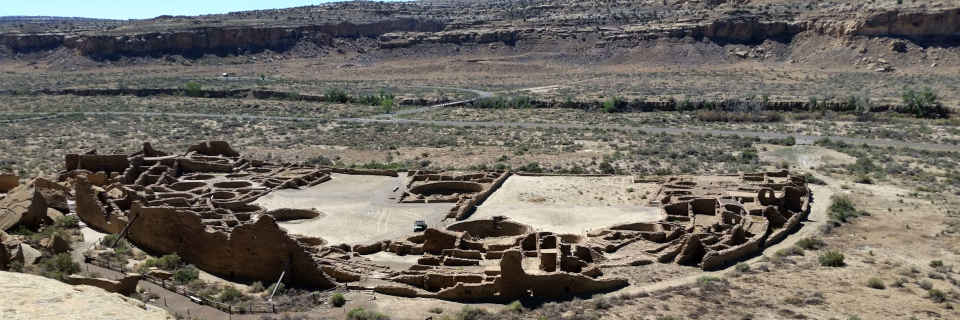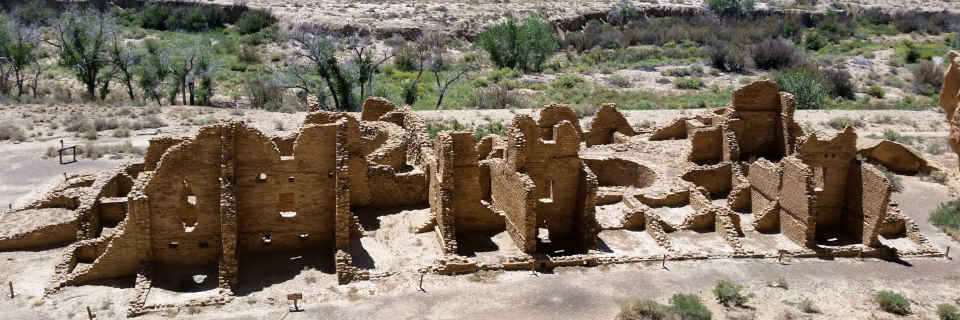Ancestral Puebloan Culture
- Archaic-Early Basketmaker Era: 7000 - 1500 BCE
- Early Basketmaker II Era: 1500 BCE - 50 CE
- Late Basketmaker II Era: 50 - 500 CE
- Basketmaker III Era: 500 - 750 CE
- Pueblo I Era: 750 - 900 CE
- Pueblo II Era: 900 - 1150 CE
- Pueblo III Era: 1150 - 1350 CE
- Pueblo IV Era: 1350 - 1600 CE
- Pueblo V Era: 1600 CE - present
The Ancestral Puebloans (formerly known as Anasazi) are probably the most studied of all prehistoric cultural groups in North America. At a time when many Europeans were living in thatched huts, the Ancestral Puebloans were building four- and five-story residential complexes and building straight-line roads tens of miles long across the high desert. The Ancestral Puebloans also enjoyed the daily use of oftentimes distinctly shaped and highly decorated pottery made with processes long lost and only now being rediscovered. Distinctive pottery was so common-place for so many years that today's archaeologists are able to reliably place events in time based on the pottery shards found in the layers of trash. Ceramic styles and decorations have allowed archaeologists to trace the migration routes of potters back and forth across the countryside.
Areas of southern Colorado, Utah and Nevada form a northern boundary of Ancestral Puebloan territory. The western boundary extends to southern Nevada while the southern boundary reaches to the Colorado and Little Colorado Rivers in Arizona and the Rio Puerco and Rio Grande in New Mexico. The eastern boundary extends onto the Great Plains as far as the Pecos and Cimarron Rivers. All that said, that "boundary" was elastic and overlapped other major cultures and, over time, other minor cultures separated and were re-included. There is evidence throughout the area that there was regular communication and dissemination of ideas, mechanical and agricultural processes, principles of architecture and engineering, and spiritual principles and practices. There is also evidence found indicating regular trade with cultures hundreds and thousands of miles away.

Pueblo Bonito, one of the Chaco Great Houses
Archaeologists say the Ancestral Puebloans became a distinct culture early in the Early Basketmaker II Era, about 3,500 years ago. Among those distinctions cited are the construction (and evolution) of the pithouse: a shallow hole in the ground covered with a thatched roof. Pithouses were also in use in the Hohokam and Mogollon areas to the south and the Hohokam were just beginning to develop irrigation systems, a necessary development given their location in the Sonoran desert. Development of irrigation also required development of the village and that was one of the developments that ushered in the Late Basketmaker II Era. Another of those developments was the vastly increased amount of maize in the people's diet. Agriculture required a more sedentary lifestyle and people probably banded together more for "distribution of labor" purposes and for security. It was in the middle of the Late Basketmaker II Era that a crude form of brown pottery first began to appear. The development of pottery also goes hand-in-hand with a more sedentary lifestyle and culture. The development of highly refined and highly decorated pottery indicates a culture of considerable sophistication.
Puebloan Great Houses first appeared in the Chaco Canyon area. The earliest were started building around 850 CE. For more about the story, visit Sites of the Ancestors.

Kin Kletso, 0ne of the Chaco Great Houses
